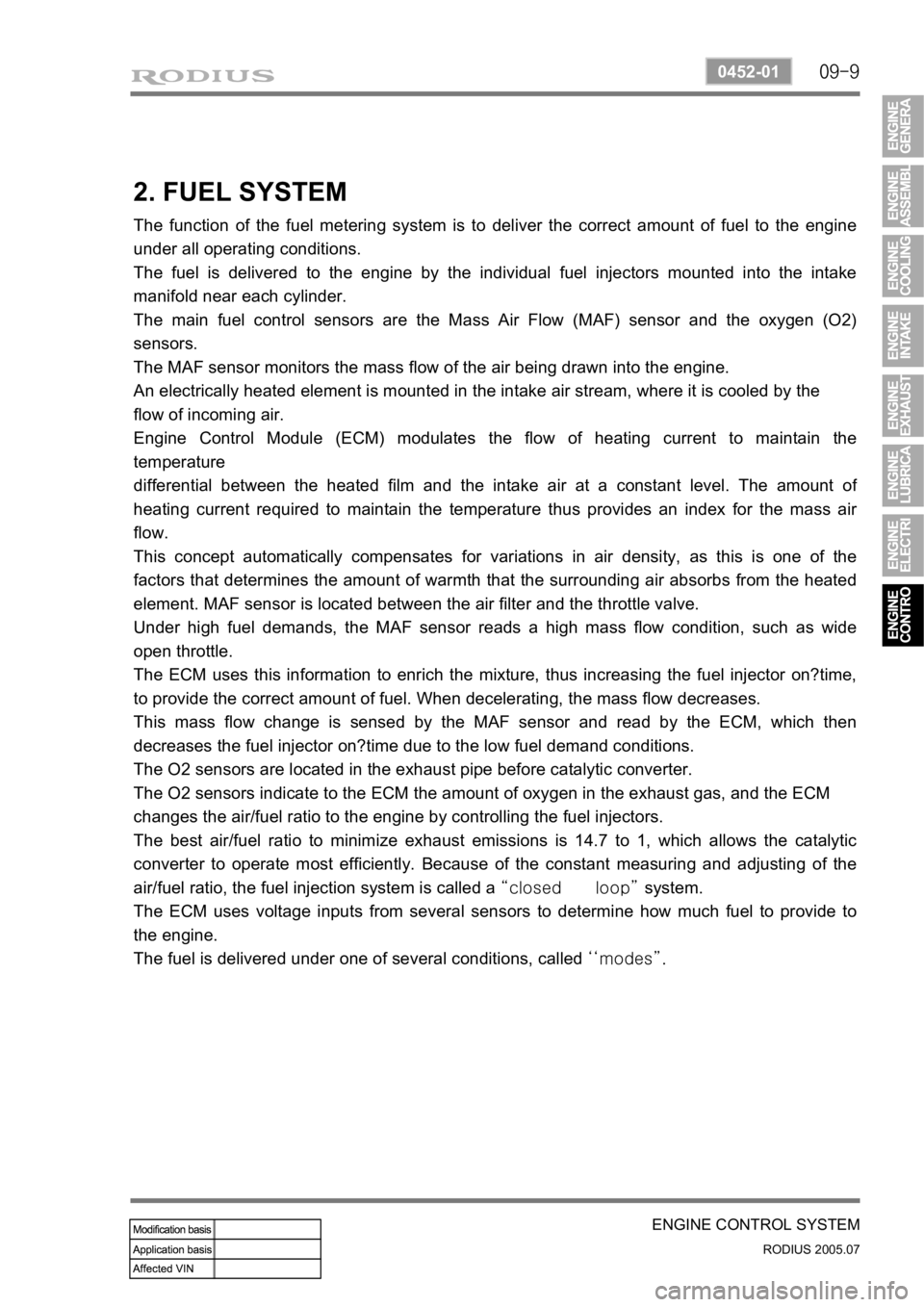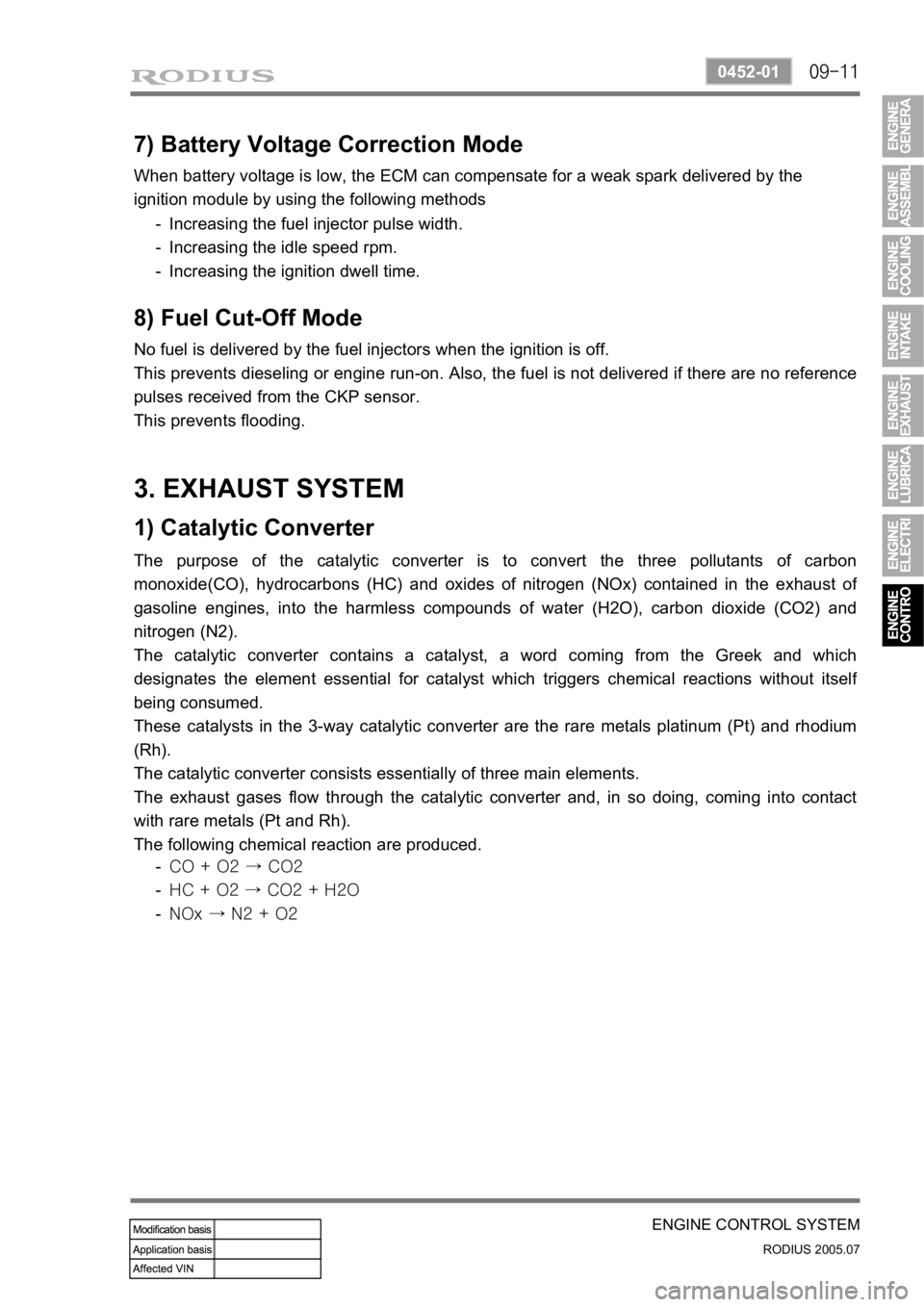catalytic converter SSANGYONG RODIUS 2005 Service Manual
[x] Cancel search | Manufacturer: SSANGYONG, Model Year: 2005, Model line: RODIUS, Model: SSANGYONG RODIUS 2005Pages: 502, PDF Size: 70.43 MB
Page 130 of 502

05-4
RODIUS 2005.07
2411-01
ENGINE EXHAUST SYSTEM
1. EXHAUST SYSTEM
When you are inspecting or replacing exhaust system components, make sure there is
adequate clearance from all points on the underbody to avoid possible overheating of the
floor panel and possible damage to the passenger compartment insulation and trim
materials. -
Check the complete exhaust system and the nearby body areas and trunk lid for broken,
damaged, missing or mispositioned parts, open seams, holes, loose connections, or othe
r
deterioration which could permit exhaust fumes to seep into the trunk may be an indication of a
problem in one of these areas. Any defects should be corrected immediately.
2. MUFFLER
Aside from the exhaust manifold connection, the exhaust system uses a flange and seal joint
design rather than a slip joint coupling design with clamp and U-bolts. If hole, open seams, o
r
any deterioration is discovered upon inspection of the front muffler and pipe assembly, the
complete assembly should be replace, the complete assembly should be replaced. The same
procedure is applicable to the rear muffler assembly.
Heat shields for the front and rear muffler assembly and catalytic converter protect the vehicle
and the environment from the high temperatures that the exhaust system develops.
3. CATALYTIC CONVERTER
When jacking or lifting the vehicle from the body side rails, be certain that the lift pads do
not contact the catalytic converter, as this could damage the catalytic converter. -
Use of anything other than unleaded fuel will damage the catalyst in the catalytic converter. -
The catalytic converter are emission-control devices added to the exhaust system to reduce
pollutants from the exhaust pipes.
The oxidation catalyst is coated with a catalytic material containing platinum and palladium,
which reduces levels of hydrocarbon (HC) and carbon monoxide (CO) from the exhaust gas.
The three-way catalyst has coatings which contain platinum and rhodium, which additionally
lower the levels of oxides of nitrogen (NOx).
Page 131 of 502

05-5
ENGINE EXHAUST SYSTEM
RODIUS 2005.07
2411-01
4. CATALYTIC CONVERTE STRUCTURE
The Catalytic converter of monolith type
consists of 2 walled metal bodies which is
made of Cordierite.
The principal element of converter consists
of the materials like Alumina or oxidized
Serume in order to apply to Ceramic
Monolith.
Washer coat operates first, and catalytic
metal elements (Pt, Pd, Rh) operates to
washer coat next.
Monolith type is lighter than other types,
easy to manufacture and quickly approaches
to proper temperature.
Washer coat is used to make a contact
surface with exhaust gas bigger by adhering
closely to small holes of inner layer.
If a lead compound or phosphorus adheres
to the surface and the temperature rises, its
surface is decreased.
The total area of general monolith converte
r
is about 45,000 ~ 500,000 ft3. (10 times of a
football field)
Generally Alumina (AL2 O3) is used as a
raw material and its 7 phases of gamma,
delta, theta have big areas and high stability
for the temperature, and nowadays gamma
Alumina is used usually.
Page 132 of 502

05-6
RODIUS 2005.07
2411-01
ENGINE EXHAUST SYSTEM
5. CATALYTIC CONVERTER AND TEMPERATURE
Catalytic converter has the normal function
of purification at a range of the temperature.
Because it has a weak point of decreasing
of the purification rate in the condition o
f
continuous high temperature, it should keep
the temperature range of 400 to 500°C for
normal condition.
HC purification rate becomes bette
r
according to the increase of temperature in
the normal range of temperature.
CO purification rate becomes the best nea
r
the temperature of 450°C, and NOx does
so near the temperature of 400 to 500°C.
Page 134 of 502

05-8
RODIUS 2005.07
2411-01
ENGINE EXHAUST SYSTEM
6. PURIFICATION OF CATALYTIC CONVERTER
Adhesion of soluble organic fraction
(SOF) below 180°C
Purification of soluble organic fraction
(SOF) over 180°C Chemical reaction
formula ·
·
- SOF(HC)+O2 → CO2+H2O
- 2CO+O2 → 2CO2
- 2C2H6+7O2 →
4CO2+6H20
By catalytic action of two primary catalytic
converter, oxidation occurs in order to
decrease HC and CO. ·
Oxygen adheres to catalytic material :
below 180°C ·
Catalytic material supplies each CO and
HC with O2 for their oxidation : above
180°C ·
Catalytic material conversion process by
DOC ·
Page 155 of 502

09-9
ENGINE CONTROL SYSTEM
RODIUS 2005.07
0452-01
2. FUEL SYSTEM
The function of the fuel metering system is to deliver the correct amount of fuel to the engine
under all operating conditions.
The fuel is delivered to the engine by the individual fuel injectors mounted into the intake
manifold near each cylinder.
The main fuel control sensors are the Mass Air Flow (MAF) sensor and the oxygen (O2)
sensors.
The MAF sensor monitors the mass flow of the air being drawn into the engine.
An electrically heated element is mounted in the intake air stream, where it is cooled by the
flow of incoming air.
Engine Control Module (ECM) modulates the flow of heating current to maintain the
temperature
differential between the heated film and the intake air at a constant level. The amount o
f
heating current required to maintain the temperature thus provides an index for the mass ai
r
flow.
This concept automatically compensates for variations in air density, as this is one of the
factors that determines the amount of warmth that the surrounding air absorbs from the heated
element. MAF sensor is located between the air filter and the throttle valve.
Under high fuel demands, the MAF sensor reads a high mass flow condition, such as wide
open throttle.
The ECM uses this information to enrich the mixture, thus increasing the fuel injector on?time,
to provide the correct amount of fuel. When decelerating, the mass flow decreases.
This mass flow change is sensed by the MAF sensor and read by the ECM, which then
decreases the fuel injector on?time due to the low fuel demand conditions.
The O2 sensors are located in the exhaust pipe before catalytic converter.
The O2 sensors indicate to the ECM the amount of oxygen in the exhaust gas, and the ECM
changes the air/fuel ratio to the engine by controlling the fuel injectors.
The best air/fuel ratio to minimize exhaust emissions is 14.7 to 1, which allows the catalytic
converter to operate most efficiently. Because of the constant measuring and adjusting of the
air/fuel ratio, the fuel injection system is called a “closed loop” system.
The ECM uses voltage inputs from several sensors to determine how much fuel to provide to
the engine.
The fuel is delivered under one of several conditions, called ‘‘modes”.
Page 157 of 502

09-11
ENGINE CONTROL SYSTEM
RODIUS 2005.07
0452-01
No fuel is delivered by the fuel injectors when the ignition is off.
This prevents dieseling or engine run-on. Also, the fuel is not delivered if there are no reference
pulses received from the CKP sensor.
This prevents flooding.
8) Fuel Cut-Off Mode
Increasing the fuel injector pulse width.
Increasing the idle speed rpm.
Increasing the ignition dwell time. -
-
- When battery voltage is low, the ECM can compensate for a weak spark delivered by the
ignition module by using the following methods
7) Battery Voltage Correction Mode
3. EXHAUST SYSTEM
1) Catalytic Converter
The purpose of the catalytic converter is to convert the three pollutants of carbon
monoxide(CO), hydrocarbons (HC) and oxides of nitrogen (NOx) contained in the exhaust o
f
gasoline engines, into the harmless compounds of water (H2O), carbon dioxide (CO2) and
nitrogen (N2).
The catalytic converter contains a catalyst, a word coming from the Greek and which
designates the element essential for catalyst which triggers chemical reactions without itsel
f
being consumed.
These catalysts in the 3-way catalytic converter are the rare metals platinum (Pt) and rhodium
(Rh).
The catalytic converter consists essentially of three main elements.
The exhaust gases flow through the catalytic converter and, in so doing, coming into contact
with rare metals (Pt and Rh).
The following chemical reaction are produced.
CO + O2 → CO2
HC + O2 → CO2 + H2O
NOx → N2 + O2 -
-
-